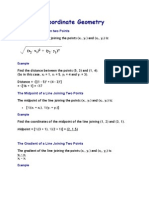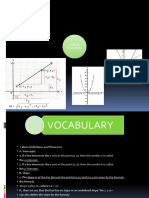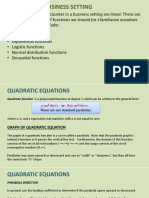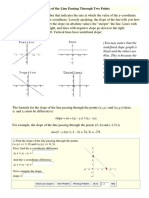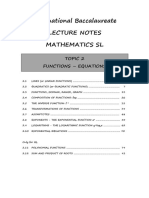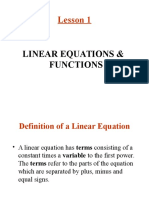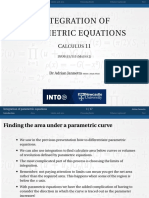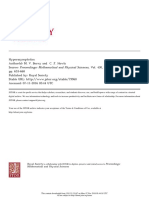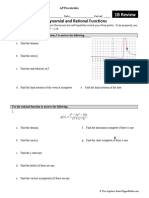Engineering Lec3
Engineering Lec3
Uploaded by
Sivar MohsinCopyright:
Available Formats
Engineering Lec3
Engineering Lec3
Uploaded by
Sivar MohsinCopyright
Available Formats
Share this document
Did you find this document useful?
Is this content inappropriate?
Copyright:
Available Formats
Engineering Lec3
Engineering Lec3
Uploaded by
Sivar MohsinCopyright:
Available Formats
Determining the equation of a line
Linear equation
Exercises involving straight lines
Circles
PreCalculus for Engineers
Dr David J.J. Devlin
Lecture 3
Determining the equation of a line
Linear equation
Exercises involving straight lines
Circles
Points, distances and midpoints
If we consider two points A and B of coordinates (x1 , y1 ) and (x2 , y2 ),
there is a unique segment of straight line joining these two points.
y
B=(x2,y2) y2 (y1+y2)/2 y1 A=(x1,y1) (x2x1) M(AB) (y2y1)
x x1 (x1+x2)/2 x2
Figure: Segment of a straight line AB and the midpoint M (AB ).
Determining the equation of a line
Linear equation
Exercises involving straight lines
Circles
Points, distances and midpoints
The length of this segment of straight line (which is the distance between
the two points) is d= p (x2 x1 )2 + (y2 y1 )2 ,
by direct application of Pythagoras theorem.
The midpoint M (AB ) of the segment AB is the centre of the segment. Its
x + x y + y 1 2 1 2 , 2 2 Example: What is the distance d between the points A = (4, 2) and B = (6, 7), and what is the midpoint M (AB )? M (AB ) = d= and p (4 6)2 + (2 7)2 = 4 + 6 2 + 7 , 2 2 4 + 81 = = 85,
coordinates are
M (AB ) =
5 5, 2
Determining the equation of a line
Linear equation
Exercises involving straight lines
Circles
Equation of a line
A curve in the (x , y )plane is specied by some equation obeyed by the
points (x , y ) lying on the curve.
An important specic curve is the straight line. A standard form of the equation of a straight line is
y = mx + b ,
y y=mx+b slope m = (yb)/x distance = yb
(x,y)
y=b distance = x
O
x x
Figure: Illustration of a straight line.
Determining the equation of a line
Linear equation
Exercises involving straight lines
Circles
Equation of a line
Such a line (illustrated in gure 2 passes through the point (0, b ), and any
other point lying on the line satises y b = m, x where m is a constant called the slope or gradient of the line. Note: This also corresponds to the tangent of the angle indicated in gure 2.
Special cases:
A horizontal line y = b has a slope m = 0. A vertical line does not have a slope (it can be seen as being innite). The equation for such lines are x =c where c is a constant. If the slope m > 0, then the value for y increases as we increase x . Conversely, if m < 0, the value for y decreases as we increase x .
Determining the equation of a line
Linear equation
Exercises involving straight lines
Circles
Equation of a line
Illustrations are provided in gure 3.
y (a) y=b x=c x x (b) y
y (c) m>o (d)
m<0
Figure: Illustration of straight lines. (a) horizontal line, (b) vertical line, (c) positive slope line and (d) negative slope line.
Determining the equation of a line
Linear equation
Exercises involving straight lines
Circles
Determining the equation of a line
A line can be specied by its slope m and one point (a, b ) it passes
through, see gure 4. The equation of the line is then or, equivalently see gure 4.
y (x,y) slope m = (yb)/(xa) (a,b) xa
y b = m (x a ), y = mx + (b ma),
yb
Figure: Illustration of a straight line with slope m, passing through the point (a, b).
Determining the equation of a line
Linear equation
Exercises involving straight lines
Circles
Determining the equation of a line
Example:
Find the equation of the straight line of gradient 3, passing through the point (1, 2). Answer: We have y 2 = 3 (x 1), y = 3x 1. Note: A wise precaution is to check that the point (1,2) lies indeed on the line; here 2-2=3(1-1).
Determining the equation of a line
Linear equation
Exercises involving straight lines
Circles
Determining the equation of a line
Another way to specify a line is to give two points (x1 , y1 ) and (x2 , y2 ) it
passes through (in Euclidean geometry).
y y2 slope m = (y2y1)/(x2x1) y2y1 y1 (x1,y1) x2x1 (x2,y2)
x1
x2
Figure: Line specied by two points it passes through.
The geometry is illustrated in gure 5.
Determining the equation of a line
Linear equation
Exercises involving straight lines
Circles
Determining the equation of a line
The slope m of the line is given by the ratio of the increase in y for a
Then a point (x , y ) along the line satises
given increase in x . So here, knowing that when x goes from x1 to x2 , y goes from y1 to y2 , y2 y1 m= . x2 x1 (y y1 ) = or equivalently (y y2 ) = y2 y1 (x x1 ), x2 x1 y2 y1 (x x2 ), x2 x1
whether you choose the point (x1 , y1 ) or (x2 , y2 ) as reference point the line passes through. Obviously either choice is right, and you will end up with the same equation in the end!
Determining the equation of a line
Linear equation
Exercises involving straight lines
Circles
Determining the equation of a line
Proof: The rst equation reads
y= y=
y2 y1 y2 y1 x x2 + y1 , x2 x1 x2 x1
(y2 y1 )x2 + (x2 x1 )y1 y2 y1 x , x2 x1 x2 x1 y2 y1 y2 x2 y1 x2 + x2 y1 x1 y1 y= x . x2 x1 x2 x1 while the second reads y= y= y2 y1 y2 y1 x x1 + y2 , x2 x1 x2 x1
(y2 y1 )x1 + (x2 x1 )y2 y2 y1 x , x2 x1 x2 x1 y2 y1 y2 x1 y1 x1 + x2 y2 x1 y2 y= x . x2 x1 x2 x1 which is the same.
Determining the equation of a line
Linear equation
Exercises involving straight lines
Circles
Determining the equation of a line
For example:
Consider the line passing through the two points (1, 3) and (2, 4). The gradient of the line is m= 34 43 1 , equivalently = , 1 2 2 (1) 3 1 1 (x (1)) = (x + 1). 3 3 y=
Now using the fact that the line passes through (1, 3) we have y 3=
10 x + . 3 3 We can check that the line passes through the two points 3= 4= 10 1 + , 3 3 2 10 + . 3 3
Determining the equation of a line
Linear equation
Exercises involving straight lines
Circles
Determining the equation of a line
We could have used the fact that the line passes through the point (2, 4)
instead to determine the equation of the line (y 4) = y= 1 (x 2), 3
2 x 10 x +4= + . 3 3 3 3
Determining the equation of a line
Linear equation
Exercises involving straight lines
Circles
Linear equation
A linear equation in x and y is a equation of the form
ax + by + c = 0. Its solution is (graphically) a straight line. If b = 0 but a = 0, the solution is the vertical line c x= . a If b = 0, the solution is the standard straight line c a y = x . b b
Determining the equation of a line
Linear equation
Exercises involving straight lines
Circles
Parallel lines
Parallel lines
Two lines are parallel if they share the same slope.
Example: Find the equation for the line L1 passing through the point
(5, 1), parallel to the line L2 joining the points (1, 1) and (5, 3)? Answer: The slope m of the line L2 is m = (3 1)/(5 1) = 1/2. So the equation of the line L1 is y 1= 1 (x 5), 2 3 x y= . 2 2
Determining the equation of a line
Linear equation
Exercises involving straight lines
Circles
Perpendicular lines
Two lines are perpendicular (or orthogonal) if the product of their slope
equals 1. In other words, consider the lines L1 of slope m1 , and L2 of slope m2 , then the lines are perpendicular if m1 m2 = 1.
Note: Special case. Recall that a horizontal line and a vertical line are
perpendicular. A vertical line has an equation of the form x = c while a horizontal line has an equation of the form y = b , with slope 0. You can see a vertical line as a line with a slope that tends to .
Determining the equation of a line
Linear equation
Exercises involving straight lines
Circles
Perpendicular lines
Illustration
y Dy (yb)=(xa)/m
m=Dy/Dx Dx (x,y) (yb)=m(xa)
Dy = (yb) (a,b) Dx = (xa)
Determining the equation of a line
Linear equation
Exercises involving straight lines
Circles
Exercises involving straight lines
Example 1
Find where the line passing through the points (1, 1) and (5, 4) intersects the x axis. Answer The gradient of the line is
5 4 1 = . 51 4 So the equation of the line (considering it passes through the point (1, 1)) is m= 5 (y 1) = (x 1), 4 9 5 y = x+ . 4 4 Along the x axis y = 0, so setting y = 0 in the equation of the line above,
9 5 x= , 4 4 9 x= . 5 The point is then (x , y ) = (9/5, 0).
Determining the equation of a line
Linear equation
Exercises involving straight lines
Circles
Example 2:
Find the line passing through (1, 2) and perpendicular to the line passing through (3, 4) and (5, 2). Where do these lines intersect? Answer The gradient of the line passing through (3, 4) and (5, 2) is m1 = So the equation of the line is (y 4) = 3(x 3), y = 3x + 13. The line perpendicular to this line has a slope m2 = 1/3, as m1 m2 = 1. Since it passes through the point (1, 2), its equation is (y 2) = y= or 3y = x + 5. 1 (x 1), 3 4 (2) = 3 35
1 5 x+ , 3 3
Determining the equation of a line
Linear equation
Exercises involving straight lines
Circles
At the intersection, wee need to satisfy both equations,
3x + y = 13 x 3y = 5
(1), (2).
To solve that, we can combine for example 3*(1) + (2) (to eliminate y ) 9x + 3y + x 3y = 39 5, 10x = 34, To nd y , we can use (20) y = 3x + 13 = 3 17/5 + 13 = 14/5 so the intersection is (17/5, 14/5). 5x = 17, x = 17/5
Determining the equation of a line
Linear equation
Exercises involving straight lines
Circles
Circles
Equation
If we consider the circle of radius r centred at the point (a, b ), the condition for the point (x , y ) to lie on the circle is that the distance between (a, b ) and (x , y ) equals r , which is conveniently expressed by (x a )2 + (y b )2 = r 2 .
y
r b
x a
Figure: Illustration of a circle of radius r centred at (a, b).
Determining the equation of a line
Linear equation
Exercises involving straight lines
Circles
Example 1
Find the equation of the circle of radius 2, centred at (1, 2). Answer: (x 1)2 + (y 2)2 = 22 = 4.
Example 2
Find the equation of the circle of radius Answer: (x )2 + (y
3, centred at (, 2)2 = 3.
2)
Determining the equation of a line
Linear equation
Exercises involving straight lines
Circles
Example 3
Find the equation of the circle for which the segment on the straight line joining the points (x1 , y1 ) = (1, 3) and the point (x2 , y2 ) = (5, 1) is a diameter. Answer: The centre (a, b ) of the circle is the midpoint of the diameter, so 1+5 31 (a , b ) = , = (3, 1) 2 2
We know now the centre of the circle. The only other bit of information
we need to nd the full equation of the circle is its radius r . There are 3 dierent, yet equivalent ways, to proceed.
Determining the equation of a line
Linear equation
Exercises involving straight lines
Circles
Recall that (a) the radius is the distance between the centre and a point lying on the circle. (b) a diameter d of the circle is twice a radius r . Using statement (a), and the information given, we may say that the radius
is the distance between points (a, b ) the centre to the point (x1 , y1 ) lying on the circle - option (a.1); or equivalently the distance between points (a, b ) the centre to the point (x2 , y2 ) lying on the circle - option (a.2)
Option (a.1) gives (for the square of the radius)
r 2 = (a x1 )2 + (b y1 )2 = (3 1)2 + (1 3)2 = 22 + 22 = 8. Hence r = 8. Option (a.2) gives r 2 = (a x2 )2 + (b y2 )2 = (3 5)2 + (1 + 1)2 = 22 + 22 = 8.
Determining the equation of a line
Linear equation
Exercises involving straight lines
Circles
The last option is (b), in which we state, that
d = r /2, squaring, d 2 = r 2 /4.
d is the length of the diameter, so d 2 = (x2 x1 )2 + (y2 y 1)2 = (5 1)2 + (3 + 1)2 = 42 + 42 = 32, so r 2 = d 2 /4 = 8. Obviously one need to use only one of the three alternatives above, as they are mathematically equivalent. Finally, we have for the circle (x 3)2 + (y 1)2 = 8.
Determining the equation of a line
Linear equation
Exercises involving straight lines
Circles
Illustration of a circle from example 3.
x
(1,3)
r2= 8 (x,y) (3,1) y O
(5,1)
Figure: Illustration of a circle of radius in example 3.
Determining the equation of a line
Linear equation
Exercises involving straight lines
Circles
Example 4
Find the equation of the circle of centre (2,3), passing through the point (5,4). Answer: The square of radius of the circle is r 2 = (5 2)2 + (4 3)2 = 10. So the equation is (x 2)2 + (y 3)2 = 10
You might also like
- Abstract Algebra Cheat SheetDocument15 pagesAbstract Algebra Cheat SheetOğul Can YurdakulNo ratings yet
- Lines, Parabolas and SystemsDocument30 pagesLines, Parabolas and Systemsmuhammad yahya0% (1)
- Genenal Aptitude (Sample) PDFDocument109 pagesGenenal Aptitude (Sample) PDFAshok Bharti67% (3)
- Banach Fixed Point TheoremDocument36 pagesBanach Fixed Point TheoremlailaNo ratings yet
- 1 2Document25 pages1 2Jhana Kimberly S. AquinoNo ratings yet
- Writing and Graphing Linear Equations 1 1Document62 pagesWriting and Graphing Linear Equations 1 1api-32711519150% (2)
- Lesson Note 5Document35 pagesLesson Note 5Solange AtabongNo ratings yet
- Lecture Notes - Coordinate GeometryDocument75 pagesLecture Notes - Coordinate GeometryAdam PauNo ratings yet
- Coordinate Geometry in The (X, Y) - Plane: 3.1. LinesDocument4 pagesCoordinate Geometry in The (X, Y) - Plane: 3.1. LinesnitinmgNo ratings yet
- Topic 9 Linear Equation and FunctionDocument47 pagesTopic 9 Linear Equation and Function1221305124No ratings yet
- Straight Line Graphs WorksheetDocument5 pagesStraight Line Graphs WorksheetDienta Alias100% (1)
- Chapter 23 The Straight LinesDocument72 pagesChapter 23 The Straight Linesthakurnavinkumar03No ratings yet
- Writing and Graphing Linear Equations 1Document62 pagesWriting and Graphing Linear Equations 1Sabreena RataniNo ratings yet
- Writing and Graphing Linear Equations 1Document62 pagesWriting and Graphing Linear Equations 1Ma. Rica Mae Rosete100% (1)
- Straight Line1Document12 pagesStraight Line1Rißhith Patel100% (1)
- Straight Line1Document12 pagesStraight Line1RAJU HARIKANo ratings yet
- UCE Book 4Document134 pagesUCE Book 4Ssonko Martin100% (1)
- Day 6 - Straight Line (Ok)Document32 pagesDay 6 - Straight Line (Ok)Daniel Piamonte100% (1)
- Coordinate Geometry 1Document34 pagesCoordinate Geometry 1Joel PrabaharNo ratings yet
- Linear Equations in Two Variables, Explain The Geometry of Lines or TheDocument10 pagesLinear Equations in Two Variables, Explain The Geometry of Lines or Thejasmin jeharaNo ratings yet
- Straight Lines HSNDocument18 pagesStraight Lines HSNapi-298592212No ratings yet
- Sekhonappliedfinitemathematics SmallDocument331 pagesSekhonappliedfinitemathematics SmallNofri Wahyu CandraNo ratings yet
- The Slope of A Straight Line Lesson 34, Section 2Document6 pagesThe Slope of A Straight Line Lesson 34, Section 2Dhanda PaniNo ratings yet
- Fundamentals of Linear Equations and Word ProblemsDocument36 pagesFundamentals of Linear Equations and Word Problemsmichelle.okoye2009No ratings yet
- G8 Math Q1-Week 6 - Graphing Linear EquationsDocument63 pagesG8 Math Q1-Week 6 - Graphing Linear Equationsmcelley2023No ratings yet
- Co-Ordinate GeometryDocument7 pagesCo-Ordinate GeometryHugh IngramNo ratings yet
- Straight LinesDocument28 pagesStraight LinesFrederick Imperial100% (1)
- Graphing Lines ReviewDocument22 pagesGraphing Lines ReviewmsagostinoNo ratings yet
- Co-Ordinate Geometry The Equation of Straight LinesDocument14 pagesCo-Ordinate Geometry The Equation of Straight LinesdugizulNo ratings yet
- RD Sharma Solution Jan2021 Class 11 Maths Chapter 23Document74 pagesRD Sharma Solution Jan2021 Class 11 Maths Chapter 23vlata7304No ratings yet
- 2.1 Equations of Lines Slope of A Line (p.68) : y M (X yDocument9 pages2.1 Equations of Lines Slope of A Line (p.68) : y M (X yAila Elocin PalmasNo ratings yet
- Coordinate GeometryDocument3 pagesCoordinate Geometrymuzakkir08No ratings yet
- Coordinate Geometry 1Document34 pagesCoordinate Geometry 1Alicia Haughton100% (1)
- Week 19 - LineDocument41 pagesWeek 19 - LineJeff LacasandileNo ratings yet
- Co-Ordinate Geometry: The X - Y PlaneDocument8 pagesCo-Ordinate Geometry: The X - Y PlaneAishwarya RaviNo ratings yet
- Functions and Their GraphsDocument148 pagesFunctions and Their Graphsayadi_ezer6795No ratings yet
- Algebra2 ProjectDocument12 pagesAlgebra2 ProjectMary AmaechiNo ratings yet
- 3rd Term s1 Further MathematicsDocument21 pages3rd Term s1 Further MathematicsFiffy McCormickNo ratings yet
- Graphs, Linear Equations, and FunctionsDocument46 pagesGraphs, Linear Equations, and FunctionsAmit BhararaNo ratings yet
- Straight Lines Straight Lines: Functions 2.1Document13 pagesStraight Lines Straight Lines: Functions 2.1Lorraine SabbaghNo ratings yet
- Topic 2. FunctionsDocument111 pagesTopic 2. FunctionsAchieNo ratings yet
- Straight Line 2Document16 pagesStraight Line 2aeeeelvishbhaiiNo ratings yet
- المحاضرة الاولىDocument8 pagesالمحاضرة الاولىQwaAlmanlawiNo ratings yet
- Alevel Support CoordGeoDocument8 pagesAlevel Support CoordGeoxapir83727No ratings yet
- 01 02 Functions Business SettingDocument35 pages01 02 Functions Business SettingFernando Lipardo Jr.No ratings yet
- Module 2 Handout-1Document12 pagesModule 2 Handout-1bearclaw131No ratings yet
- 10-2Document9 pages10-2Md SaifNo ratings yet
- Calculus Book IDocument19 pagesCalculus Book ITeresa Villena GonzálezNo ratings yet
- NCERT Solutions For Class 11 Maths Chapter 10 Straight Lines Exercise 10.2Document15 pagesNCERT Solutions For Class 11 Maths Chapter 10 Straight Lines Exercise 10.2ashiyanakapoor9No ratings yet
- 6.1 Different Forms of Linear EquationsDocument5 pages6.1 Different Forms of Linear EquationsVesuvius KantNo ratings yet
- Equation of A LineDocument27 pagesEquation of A LinedkealmadronesNo ratings yet
- 12 Linear EquationsDocument26 pages12 Linear EquationsElmabeth Dela CruzNo ratings yet
- Topic 2. Functions - EquationsDocument79 pagesTopic 2. Functions - Equationskingpsy26No ratings yet
- Analytic Geometry 1 PDFDocument37 pagesAnalytic Geometry 1 PDFDaniel Danille KristianNo ratings yet
- Lesson 1Document47 pagesLesson 1Syuhaidah Binti Aziz ZudinNo ratings yet
- Igcse Pure Maths (9-1) : Coordinate Geometry Lecture - 3 07Th May, ThursdayDocument17 pagesIgcse Pure Maths (9-1) : Coordinate Geometry Lecture - 3 07Th May, ThursdayabrarjayNo ratings yet
- Coordinate Geometry Topic 6: AB X X y yDocument4 pagesCoordinate Geometry Topic 6: AB X X y ySyed Abdul Mussaver ShahNo ratings yet
- 2022 - T1 - WK5 - Linear Relationship L3Document6 pages2022 - T1 - WK5 - Linear Relationship L3cha0tic.cookiemxnsterNo ratings yet
- Graphing WorkbookDocument21 pagesGraphing WorkbookElaine zhuNo ratings yet
- 3 9 10 - Solid Mensuration - General and Standard Equation of A Line - DONEDocument12 pages3 9 10 - Solid Mensuration - General and Standard Equation of A Line - DONEEloiza Lajara RamosNo ratings yet
- A-level Maths Revision: Cheeky Revision ShortcutsFrom EverandA-level Maths Revision: Cheeky Revision ShortcutsRating: 3.5 out of 5 stars3.5/5 (8)
- Transformation of Axes (Geometry) Mathematics Question BankFrom EverandTransformation of Axes (Geometry) Mathematics Question BankRating: 3 out of 5 stars3/5 (1)
- Conic Section Locus Focus Eccentricity DirectrixDocument21 pagesConic Section Locus Focus Eccentricity DirectrixJohn Ahmir LawasNo ratings yet
- Introduction To The Finite Element Method: Part A: Rayleigh-Ritz MethodDocument10 pagesIntroduction To The Finite Element Method: Part A: Rayleigh-Ritz MethodluisNo ratings yet
- First Periodic Exam in Mathematics 8 - AsatDocument4 pagesFirst Periodic Exam in Mathematics 8 - AsatKristell Alipio100% (1)
- Ntegration of Parametric Equations: AlculusDocument17 pagesNtegration of Parametric Equations: Alculusantz12345No ratings yet
- EquationsDocument10 pagesEquationsapokakiaNo ratings yet
- Topic 1: Solving Single Variable Equations: (DR - Jang WS)Document20 pagesTopic 1: Solving Single Variable Equations: (DR - Jang WS)Han Thai Pham (Hannah)No ratings yet
- Hyperasymptotics (Berry and Howl)Document17 pagesHyperasymptotics (Berry and Howl)Jason UchennnaNo ratings yet
- Chapter 1 Number SystemDocument26 pagesChapter 1 Number SystemArun kumarNo ratings yet
- ST M Hdstat RNN Deep LearningDocument46 pagesST M Hdstat RNN Deep Learning김기한No ratings yet
- Signals and Systems Question BankDocument3 pagesSignals and Systems Question BankEdward HarveyNo ratings yet
- Tos MathDocument2 pagesTos MathVenus Mantaring LastraNo ratings yet
- Algebra SDocument7 pagesAlgebra Sสฮาบูดีน สาและNo ratings yet
- Class 12 Revision Notes MatricesDocument8 pagesClass 12 Revision Notes MatricesAbinash katochNo ratings yet
- Inversse Trigs TechniqueesDocument9 pagesInversse Trigs TechniqueesCriston B. DingdingNo ratings yet
- Math 7 ModuleDocument15 pagesMath 7 Moduleronnie yago50% (4)
- Assign5 PDFDocument2 pagesAssign5 PDFAkhlaq HusainNo ratings yet
- 100908/Ma200A: Vector Calculus Differentialequations and Transforms Course Handout Module 4: Laplace TransformsDocument35 pages100908/Ma200A: Vector Calculus Differentialequations and Transforms Course Handout Module 4: Laplace TransformsAakanksha KartikNo ratings yet
- 954/2 STPM: SMK Seri SetiaDocument5 pages954/2 STPM: SMK Seri SetiaKomagan A/L Rajoo IPGKPTNo ratings yet
- Appc Unit 1b ReviewDocument5 pagesAppc Unit 1b Reviewjayanth.vinaveeraNo ratings yet
- Solutions To BookDocument48 pagesSolutions To BookRAGHUL MNo ratings yet
- Chapter 4 Functions and GraphDocument67 pagesChapter 4 Functions and Graphabdullahhaiyan786No ratings yet
- St. Gabriel International SchoolDocument2 pagesSt. Gabriel International SchoolJOHN MICHAELNo ratings yet
- All Problems and AnswersDocument31 pagesAll Problems and AnswerstarhuniNo ratings yet
- 10 Arts CH # 2 TestDocument2 pages10 Arts CH # 2 TestAli ButtNo ratings yet
- (P. - J. - Higgins) - An Introduction To Topological GroupsDocument119 pages(P. - J. - Higgins) - An Introduction To Topological GroupsEstevan LuizNo ratings yet
- ECEg 3141 Z-TransformDocument33 pagesECEg 3141 Z-TransformEyoab TarikuNo ratings yet
- Supercritical Solutions of The Stationary Positive Forced KDV EquationDocument10 pagesSupercritical Solutions of The Stationary Positive Forced KDV EquationerpublicationNo ratings yet































